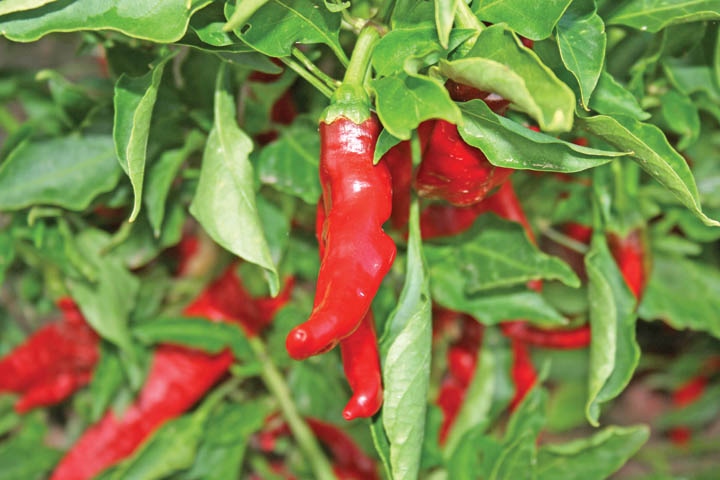September 30, 2010

The future of food continues to evolve from the basic sustenance of nourishment for human life to the consumer’s desire for a personal involvement in the food supply.
Consumers today want personal exposure to plant and animal production, says Lowell Catlett, agricultural economist, futurist, and dean of New Mexico State University’s College of Agriculture, Consumer, and Environmental Sciences.
Consumers’ hunger for agriculture follows multiple generations of people who no longer farm. Long gone for many are their grandpas and grandmas who worked the land.
Catlett pointed to consumer interest in New Mexico’s chile pepper industry. Red and green chile vegetables add a spicy flavor when cooked with other foods. Pepper ristras, arrangements of drying pepper pods, are often hung from the eves of homes as an exclamation of the New Mexico lifestyle.
This type of mental conversion – from food for nourishment to a hands-on experience – is what Catlett calls “dream space.”
Raising chickens is an example of what consumers want relating to a personal experience with plants and animals. In 2008, 60 percent of the towns and municipalities in America considered ordinances to allow raising chickens in urban areas. Catlett says about 30 percent of those entities approved the measures.
“Some people want to raise chickens on balconies in New York (City),” Catlett said with a smirk. “I think it’s a phenomenal thing for agriculture. Consumers will have to haul a lot of food (feed) up the elevators and then haul a lot of other ‘stuff’ (manure) back down. They will learn how hard it is to produce a safe and abundant food system.”
Food interest growing worldwide
Consumer interest in food is growing worldwide as personal incomes rise. Worldwide, 2 billion people that once lived in “abject poverty” have risen to the middle class in the last 20 years.
“When you start getting a little bit more money – especially when you start out in abject poverty where you are just trying to get through the day – the first change is in your food consumption,” Catlett explained.
Income has almost tripled in China over the last 15 years which has led to a four-fold increase in the per-capita consumption of meat-based protein. Beef consumption doubled in India as incomes rose.
“The change starts with meat and extends into other (food) arenas,” Catlett said. “With 2 billion people you see a rise in the demand for many food products.”
Consumer interest in food is also changing in North America. Today, one in eight U.S. citizens is an immigrant (non-native born). In Canada, the rate is one in five. Immigrants under the age of 13 who become citizens in a new country bring food consumption habits from their previous home country.
Catlett discussed the relationship of food to the entire human experience. He illustrated how people’s priorities change based on American psychologist Abraham Maslow’s famous “hierarchy of human needs” formula.
The pyramid-shaped human equation starts with humans meeting their first basic physiological needs: food, water, sleep, sex and safety.
“This was my father’s generation – the Great Depression and World War II – when food was scarce,” Catlett explained. “(They were told) Eat everything on your plate because there are starving children in the world.”
Feeding the world
In those days the world population was about 4 billion people. About 1,300 calories of food per day per person was generally available, but not enough to adequately sustain the human body. Starvation was common.
Today’s more productive agriculture with higher yields feeds about 6.6 billion people. About 2,600 calories are available on average per person.
“We won the (production) battle,” Catlett said. “We can feed the world.”
Maslow’s next pyramid step is to find someone to share food, love and acceptance. This again is dream space. Some people want organically- and locally-grown food, food grown under carbon neutral conditions, and free range chickens.
“I grew up on a ranch and we had free range chickens,” Catlett smirked. “You watch what they eat (their own manure). I prefer my chicken grown on corn and soybeans.”
“Five years ago some European supermarkets began placing photos and videos in the stores of the actual farmers who grew the food on the store shelves. This allowed consumers to put a face with the crop and learn how the farmer grew the crop.”
Today in New Mexico, ranchers earn about 15 percent of their income from hunters in search of prized trophy animals.
Corn farmers are benefitting from the public’s puzzling interest in agriculture.
“Who would have thought that someone would pay to get lost in a corn maize?” Catlett quipped.
Research results enforce the belief that people enjoy the presence of plants and animals. A Ferrari automotive plant in Italy has glass walls so workers can watch the plants grow outside and observe cows grazing on the hillsides. As a result worker productivity increased.
“We know the healing power of animals; we like to be together,” Catlett said. “Those of us in agriculture know the healing power of the presence of a cow or horse.”
You May Also Like




